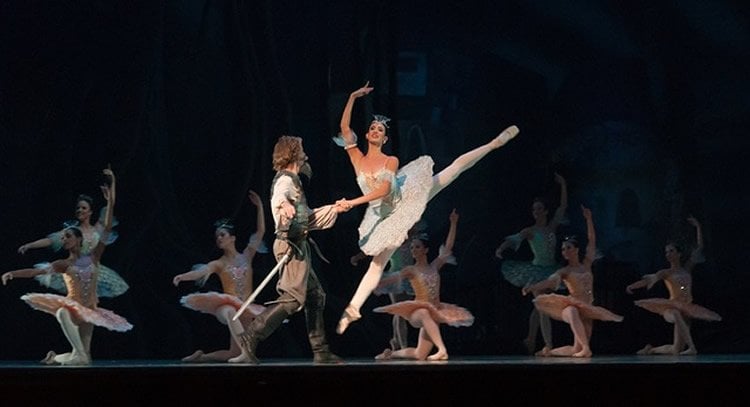The NIH-supported study holds applications for areas including autism, schizophrenia, robotic research and sport rehabilitation.
A new study is a rare look into the delicate dynamics of social movement, and shows how people avoid bumping into each other while doing complementary, coordinated tasks such as dancing. The research reveals that people fall into a specific pattern to avoid a collision. The study led by Michael J. Richardson, a University of Cincinnati associate professor of psychology, is published in the highly ranked Journal of Experimental Psychology: Human Perception and Performance, a journal of the American Psychological Association.
The study involved 12 pairs of two participants simultaneously moving objects on a 50-inch computer screen from one location to another – without bumping their objects into each other – using a hand-held motion-tracking sensor to control their movements. The virtual tasks included moving a dot on the computer screen from bottom-left to top-right for one participant and bottom-right to top-left for the partnering participant.
“This task was chosen because many joint actions involve the continuous production of repetitive movements over time,” write the authors. “For instance, the same or similar movements are performed in a repetitive manner when two individuals are loading a dishwasher, stacking a pile of blocks or magazines, or dancing or (Kung Fu) fighting together. These social activities, however, do not involve the incidental inphase or antiphase movement synchronization that has been the focus of previous studies of social coordination. On the contrary, they require that individuals explicitly avoid colliding into each other and establish a more complex or complementary pattern of movement coordination – since prototypical inphase or antiphase patterns of movement coordination would result in task failure.”
While no specific instructions were given to participants on how to coordinate their movements, the experiment found that nearly all of the pairs fell into the same stable pattern of coordination, with one participant adopting a more straight-line trajectory between the targets, and the partner falling into a more elliptical trajectory between the targets. “Of particular significance, task success was dependent on the participants discovering this complementary task solution,” the authors explain.
All 24 participants were college undergraduates and were right-handed. The pairs stood back to back while performing the tasks. They could not see each other, but they could see their partner’s virtual dot movement on the screen. A Polhemus FASTRACK magnetic motion tracking system recorded and tracked the movements of each participant.
The researchers reported a total of 164 successful trials completed by the pairs. On average, the 11 pairs retained for analysis took 21 trials to reach a score of 15.

Richardson explains that as researchers make strides in understanding the coordination of interpersonal movement, then these discoveries could support research in areas ranging from the social coordination of children with autism, people with schizophrenia, human interaction with robotics and sport rehabilitation.
“Once you gain an understanding of normative dynamics, we can better diagnose when those dynamics are not working properly and also design interventions,” explains Richardson. “We’ve developed a dynamic model that captures the behavioral dynamics as well as provides a theoretical explanation of why certain behavior emerges between people as they learn to avoid each other while performing certain tasks.”
Co-authors on the paper are Steven Harrison, a research associate for the University of Nebraska Omaha; Rachel Kallen, a UC assistant professor of psychology; Ashley Walton, a UC doctoral student in psychology; Brian Eiler, a UC doctoral student in psychology; Elliott Saltzman, a professor in the Department of Physical Therapy at Boston University; and Richard Schmidt, a psychology professor at the College of the Holy Cross in Worcester, Massachusetts.
Funding: The research was conducted in the UC Department of Psychology’s Center for Cognition, Action and Perception. Funding for the study was supported by a $1.4 million grant from the National Institutes of Health awarded to the UC Department of Psychology in 2013. The five-year grant supports the development of computerized models to examine how social interaction and movement influence each other.
Written by Dawn Fuller
Source: University of Cincinnati
Image Source: The image is in the public domain
Original Research: Abstract for “Self-Organized Complementary Joint Action: Behavioral Dynamics of an Interpersonal Collision-Avoidance Task” by Richardson, Michael J.; Harrison, Steven J.; Kallen, Rachel W.; Walton, Ashley; Eiler, Brian A.; Saltzman, and Elliot; Schmidt, R. C. in Journal of Experimental Psychology: Human Perception and Performance. Published online March 9 2015 doi:10.1037/xhp0000041
Abstract
Self-Organized Complementary Joint Action: Behavioral Dynamics of an Interpersonal Collision-Avoidance Task
Understanding stable patterns of interpersonal movement coordination is essential to understanding successful social interaction and activity (i.e., joint action). Previous research investigating such coordination has primarily focused on the synchronization of simple rhythmic movements (e.g., finger/forearm oscillations or pendulum swinging). Very few studies, however, have explored the stable patterns of coordination that emerge during task-directed complementary coordination tasks. Thus, the aim of the current study was to investigate and model the behavioral dynamics of a complementary collision-avoidance task. Participant pairs performed a repetitive targeting task in which they moved computer stimuli back and forth between sets of target locations without colliding into each other. The results revealed that pairs quickly converged onto a stable, asymmetric pattern of movement coordination that reflected differential control across participants, with 1 participant adopting a more straight-line movement trajectory between targets, and the other participant adopting a more elliptical trajectory between targets. This asymmetric movement pattern was also characterized by a phase lag between participants and was essential to task success. Coupling directionality analysis and dynamical modeling revealed that this dynamic regime was due to participant-specific differences in the coupling functions that defined the task-dynamics of participant pairs. Collectively, the current findings provide evidence that the dynamical coordination processes previously identified to underlie simple motor synchronization can also support more complex, goal-directed, joint action behavior, and can participate the spontaneous emergence of complementary joint action roles.
“Self-Organized Complementary Joint Action: Behavioral Dynamics of an Interpersonal Collision-Avoidance Task” by Richardson, Michael J.; Harrison, Steven J.; Kallen, Rachel W.; Walton, Ashley; Eiler, Brian A.; Saltzman, and Elliot; Schmidt, R. C. in Journal of Experimental Psychology: Human Perception and Performance. Published online March 9 2015 doi:10.1037/xhp0000041






